Heirloom daffodils are proven hardy, beautiful flowering plants that stand the test of time. And many heirloom varieties are some of the sweetest-smelling daffodils you’ll ever find! So keep reading to discover 10 types of heirloom daffodils we think are steadfast beauties, plus learn more about growing these historic plants. They could dazzle you with their showy heirloom blooms every spring for many years to come.
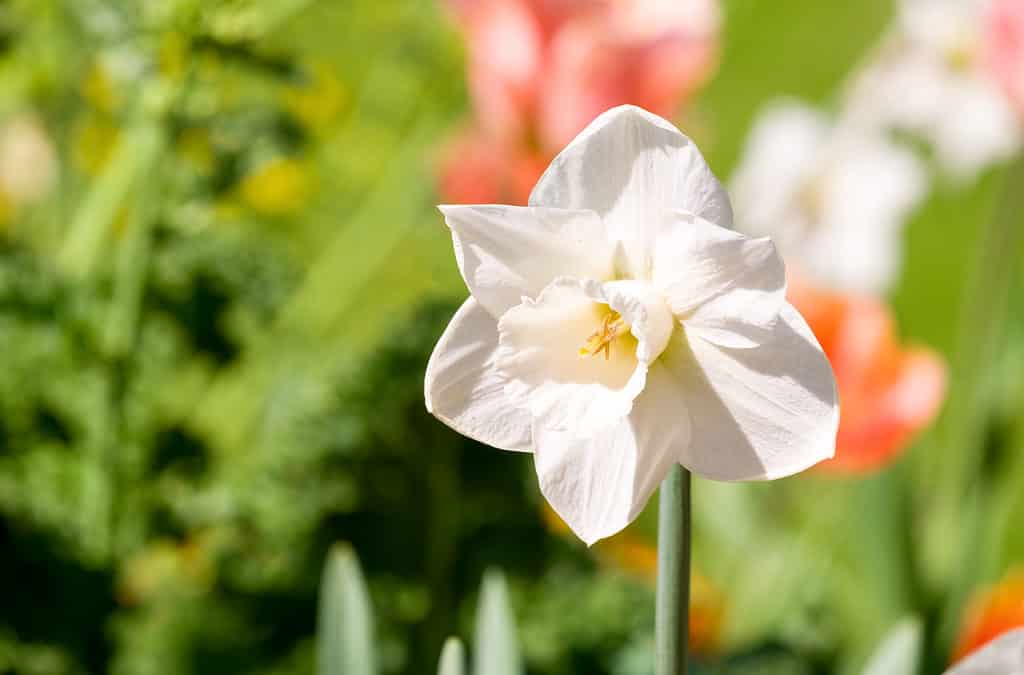
Heirloom daffodils are dependable blooming cultivars and also hardy plants.
©Jacques Julien/Shutterstock.com
What are heirloom daffodils?
Heirloom daffodils are classic plants cultivated to become hardy and maintain distinct characteristics, like color and size. They might also be called historic, heritage, or old-fashioned daffodils
Heirloom daffodils are typically hardier and more disease-resistant than other varieties, making them a wonderful plant for home gardens. They also tend to have a longer blooming season.
Generally, an heirloom daffodil is at least 50 years old. However, some historic daffodils, like the pheasant’s eye variety (Narcissus poeticus var. recurvus), have been around for hundreds of years.
How are heirloom daffodils classified?
The Royal Horticultural Society (RHS) developed the official classification system for all daffodils, including the heirloom varieties. Every heirloom daffodil also falls into one of the RHS 13 daffodil divisions listed below.
The 13 daffodil divisions are the following:
- Division #1, Trumpet Daffodils
- Division #2, Large-Cupped Daffodils
- Division #3, Small-Cupped Daffodils
- Division #4, Double Daffodils
- Division #5, Triandrus Daffodils
- Division #6, Cyclamineus Daffodils
- Division #7, Jonquilla Daffodils
- Division #8, Tazetta Daffodils
- Division #9, Poeticus Daffodils
- Division #10, Bulbocodium Daffodils
- Division #11a, Split-Cupped Collar Daffodils
- Division #11b, Split-Cupped Papillion Daffodils
- Division #12, Other Daffodil Cultivars
- Division #13, Daffodils Categorized Only by Botanical Name
These divisions help gardeners identify and understand the growth habits of each daffodil type. And the traits outlined in the 13 daffodil divisions will also help you determine which types of heirloom daffodils from our list below you might want to grow.
For more info about daffodil types and their characteristics, check out our article on the 13 daffodil divisions explained!
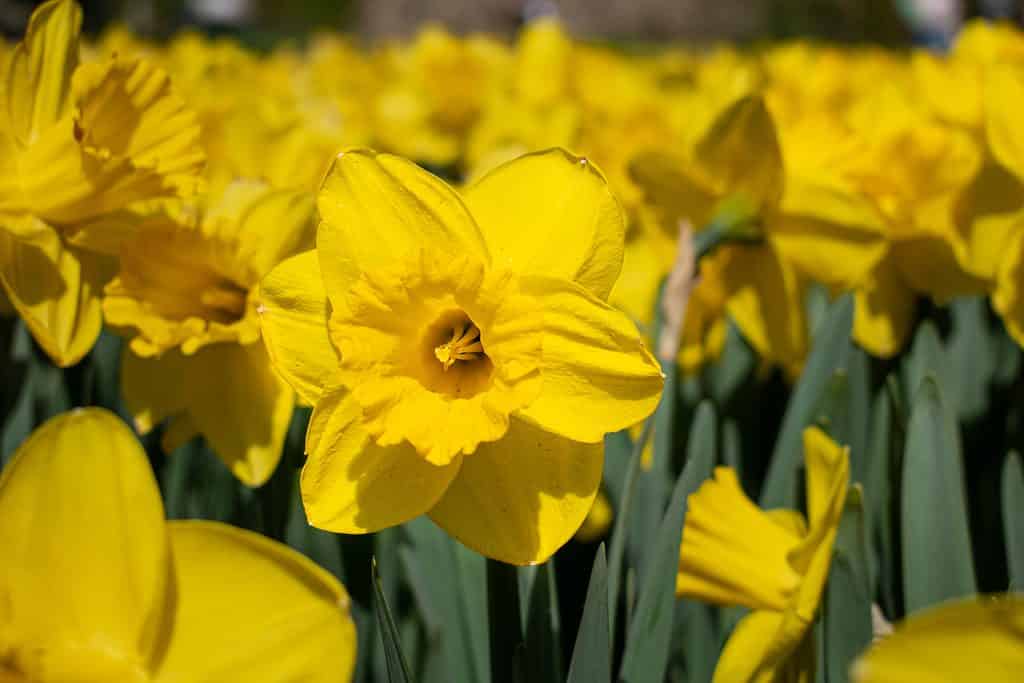
The ‘Dutch Master’ cultivar is a trumpet heirloom daffodil.
©Dajbog Nicoleta/Shutterstock.com
1. ‘Dutch Master’ Daffodil
Plant Botanical Name: Narcissus ‘Dutch Master’
Common Plant Names: ‘Dutch Master’ daffodil, ‘Dutch Master’ trumpet daffodil
Plant Hardiness Zones: 3-9
Seasons in Bloom: Mid-Spring
Daffodil Division: Trumpet (Division #1)
Flower Colors: Bright yellow cups and petals
The lightly-scented ‘Dutch Master’ heirloom daffodil has been around since 1938. This bulb flower is a classic yellow trumpet daffodil with large, showy blooms up to 4 inches across. It grows an average of 18 inches tall, and each stem produces one bloom.
‘Dutch Master’ is a vigorous plant that naturalizes easily in yards, meadows, and fields. It’s also one of the most loved historic daffodils available for home gardening today.
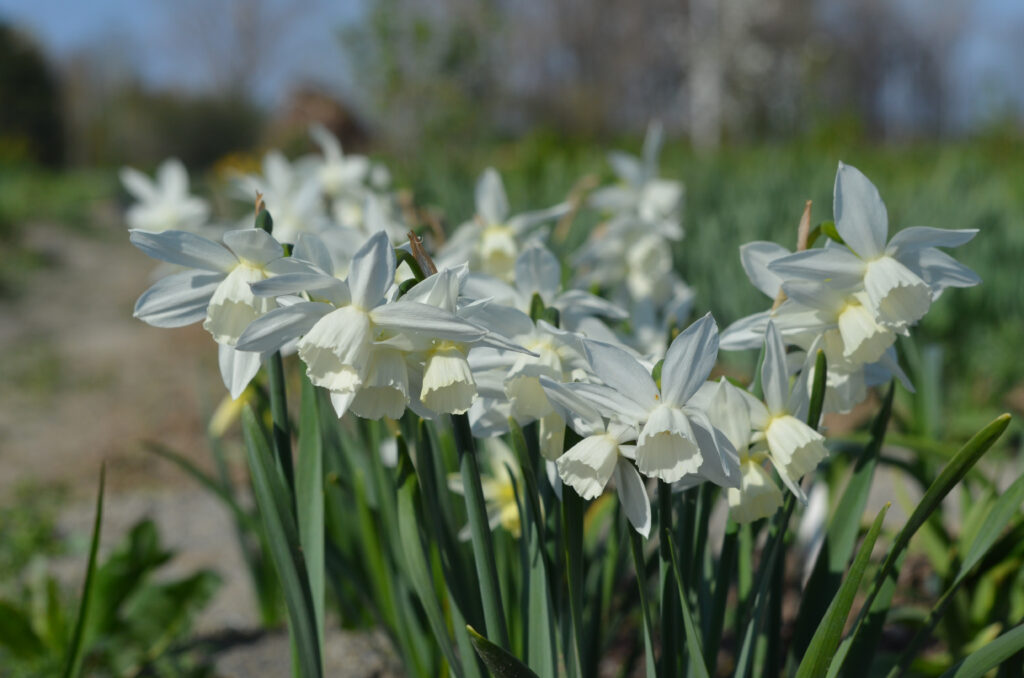
‘Thalia’ triandrus daffodils are heirloom plants from 1916.
©/Shutterstock.com
2. ‘Thalia’ Daffodil
Plant Botanical Name: Narcissus ‘Thalia’
Common Plant Names: Old Narcissus, ‘Thalia’ daffodil, ‘Thalia’ triandrus daffodil
Plant Hardiness Zones: 3-9
Seasons in Bloom: Mid-Spring
Daffodil Division: Triandrus (Division #5)
Flower Colors: White petals and white cups
Also called Old Narcissus, the ‘Thalia’ daffodil is an all-white and fragrant type of heirloom daffodil. It has frilly cups on 4-inch flowers and usually produces 2-3 blooms per stem.
‘Thalia’ is a triandrus daffodil from 1916. This showy plant has long-lasting flowers and grows 12-24 inches tall.
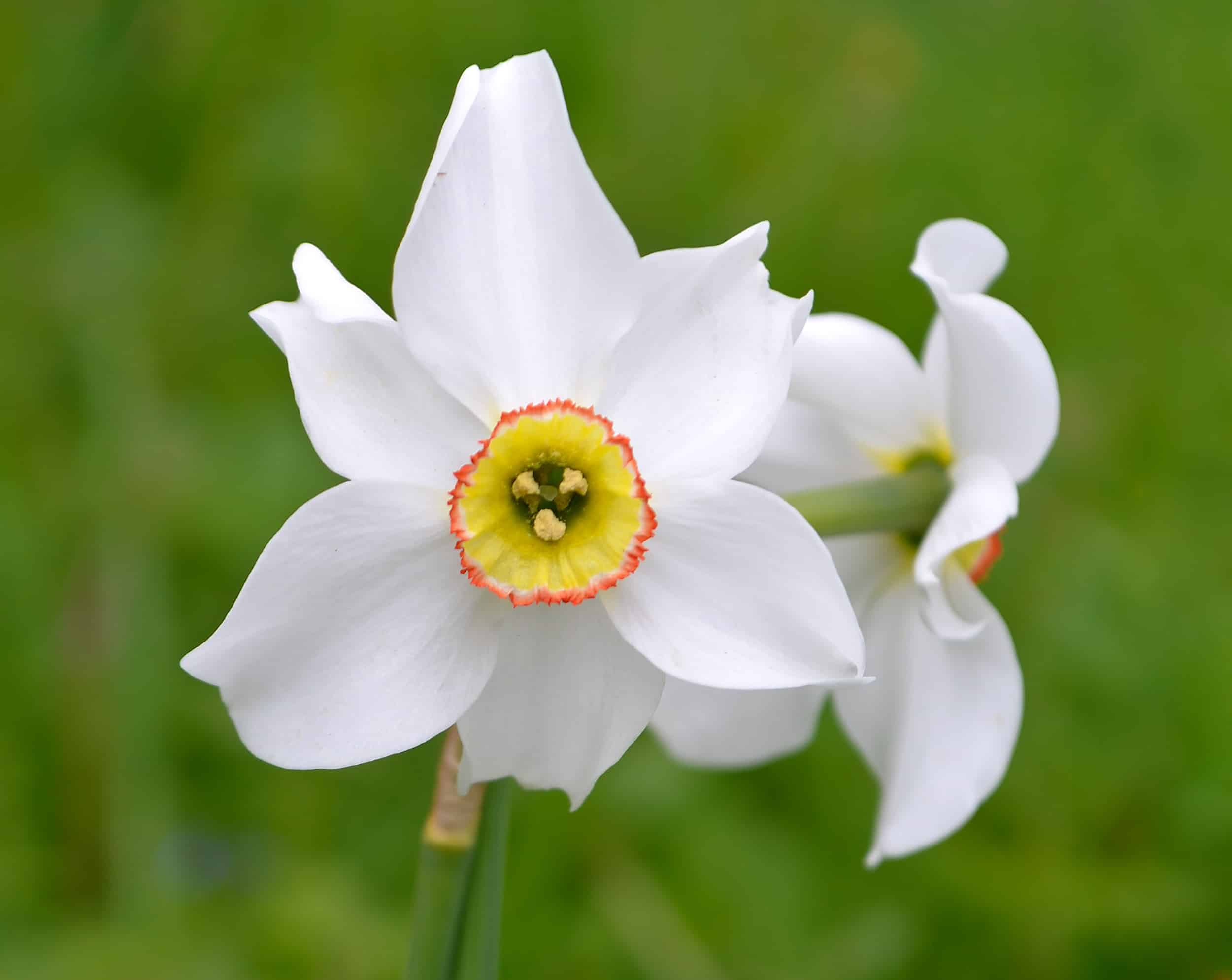
The
Narcissus poeticusvar.
recurvusis an heirloom daffodil with unique coloring and style.
©Emily Goodwin/Shutterstock.com
3. Narcissus poeticus var. recurvus (Pheasant’s Eye Daffodil)
Plant Botanical Name: Narcissus poeticus var. recurvus
Common Plant Names: ‘Pheasant’s Eye’ daffodil, recurvus daffodil, poet’s daffodil
Plant Hardiness Zones: 3-9
Seasons in Bloom: Late Spring
Daffodil Division: Poeticus (Division #9)
Flower Colors: White petals and yellow-green cups with a deep red ring inside the cup
The ‘Pheasant’s Eye’ cultivar is an heirloom daffodil grown in Europe since 1831 but could be as old as the early 1600s. The flowers have a dramatic look with pristine white petals and yellow cups featuring a deep red ring around the outer edge. In fact, its yellow and green cups rimmed with red are why this heirloom daffodil is called pheasant’s eye.
This unique type of daffodil is a late bloomer every spring and reaches 1-2 feet tall. ‘Pheasant’s Eye’ is also another heirloom daffodil with a strong and delightful fragrance.

The ‘Tête-à-Tête cultivar is a miniature heirloom daffodil with pretty yellow reflexed petals
©Helen J Davies/Shutterstock.com
4. ‘Tête-à-Tête’ Daffodil
Plant Botanical Name: Narcissus ‘Tête-à-Tête’
Common Plant Names: ‘Tête-à-Tête’ daffodil, ‘Tête-à-Tête’ dwarf daffodli
Plant Hardiness Zones: 3-9
Seasons in Bloom: Early through Mid-Spring
Daffodil Division: Cyclamineus (Division #6)
Flower Colors: yellow-orange cups with bright yellow petals
Cheery yellow-orange ‘Tête-à-Tête’ is a miniature daffodil first introduced in 1949. This fragrant cyclamineus daffodil has petite 2-3 inch blooms on plants that grow about 6-10 inches high.
Like other cyclamineus daffodils, ‘Tête-à-Tête’ produces one flower per stem and around six flowers per plant. This historic daffodil is also one of the earliest bulb flowers to bloom in the spring.

‘Ice Follies’ is an heirloom daffodil from 1963.
©Ausra Barysiene/Shutterstock.com
5. ‘Ice Follies’ Daffodil
Plant Botanical Name: Narcissus’ Ice Follies’
Common Plant Names: ‘Ice Follies’ daffodil, ‘Ice Follies’ large-cupped daffodil
Plant Hardiness Zones: 3-9
Seasons in Bloom: Early to Mid-Spring
Daffodil Division: Large-Cupped (Division #2)
Flower Colors: White petals with yellow cups that mature to white
‘Ice Follies’ is an elegant white and yellow heirloom daffodil with a sweet scent. This classic large-cupped daffodil is from 1963. It’s also a color-changing variety because its cups mature from yellow to white.
The ‘Ice Follies’ daffodil cultivar is both showy and hardy, with plant heights between 18-24 inches at maturity. This award-winning historic daffodil also produces blooms up to 4 inches across.

The ‘Carlton’ cultivar is a bright and cheery heirloom daffodil from 1927.
©PQK/Shutterstock.com
6. ‘Carlton’ Daffodil
Plant Botanical Name: Narcissus’ Carlton’
Common Plant Names: ‘Carlton’ daffodil, ‘Carlton’ large-cupped daffodil
Plant Hardiness Zones: 3-8
Seasons in Bloom: Mid-Spring
Daffodil Division: Large-Cupped (Division #2)
Flower Colors: Golden yellow cups and petals
With its huge, showy flowers and sweet vanilla scent, the ‘Carlton’ cultivar is a very popular historic daffodil! It has 4-5 inch all-yellow blooms with ruffled cups and grows 12-25 inches tall.
‘Carlton’ first came on the scene in 1927 and has made a big yellow splash across home gardens (and flower competitions) worldwide ever since.

‘Mount Hood’ heirloom daffodils have cups that change from yellow to cream, then white.
©Alex Manders/Shutterstock.com
7. ‘Mount Hood’ Daffodil
Plant Botanical Name: Narcissus’ Mount Hood’
Common Plant Names: ‘Mount Hood’ daffodil, ‘Mount Hood’ trumpet daffodil
Plant Hardiness Zones: 3-9
Seasons in Bloom: Mid-Spring
Daffodil Division: Trumpet (Division #1)
Flower Colors: White petals with a pretty yellow cup that changes to cream and white
A picture of elegance, the ‘Mount Hood’ cultivar is a stunning white daffodil with a yellow cup that matures to cream and finally white. In addition, this heirloom daffodil makes a grand statement in the garden with its frilly 4-5 inch blooms.
Available since 1921, ‘Mount Hood’ is a classic white daffodil that classes up any plots or pots it graces with its magnificent flowers in mid-spring.
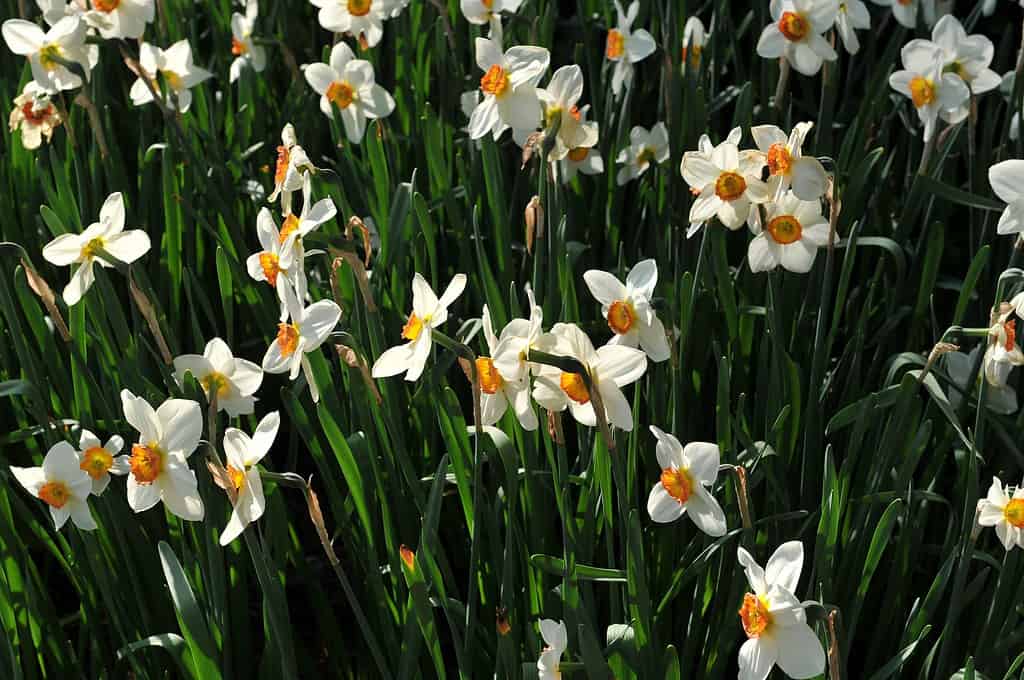
‘Aflame’ bicolor heirloom daffodil originated in 1938.
©Sergey V Kalyakin/Shutterstock.com
8. ‘Aflame’ Daffodil
Plant Botanical Name: Narcissus ‘Aflame’
Common Plant Names: ‘Aflame’ daffodil, ‘Aflame’ small-cupped daffodil
Plant Hardiness Zones: 4-7
Seasons in Bloom: Early to Mid Spring
Daffodil Division: Small-Cupped (Division #3)
Flower Colors: Reddish-orange cups and white petals
A registered daffodil since 1938, ‘Aflame’ is also a very striking white and red-orange heirloom daffodil. This beauty is a small-cupped daffodil, but its showy flowers grow 4-5 inches wide.
‘Aflame’ plants grow 12-18 inches tall on average and show off their bicolor blooms in early to mid-spring.
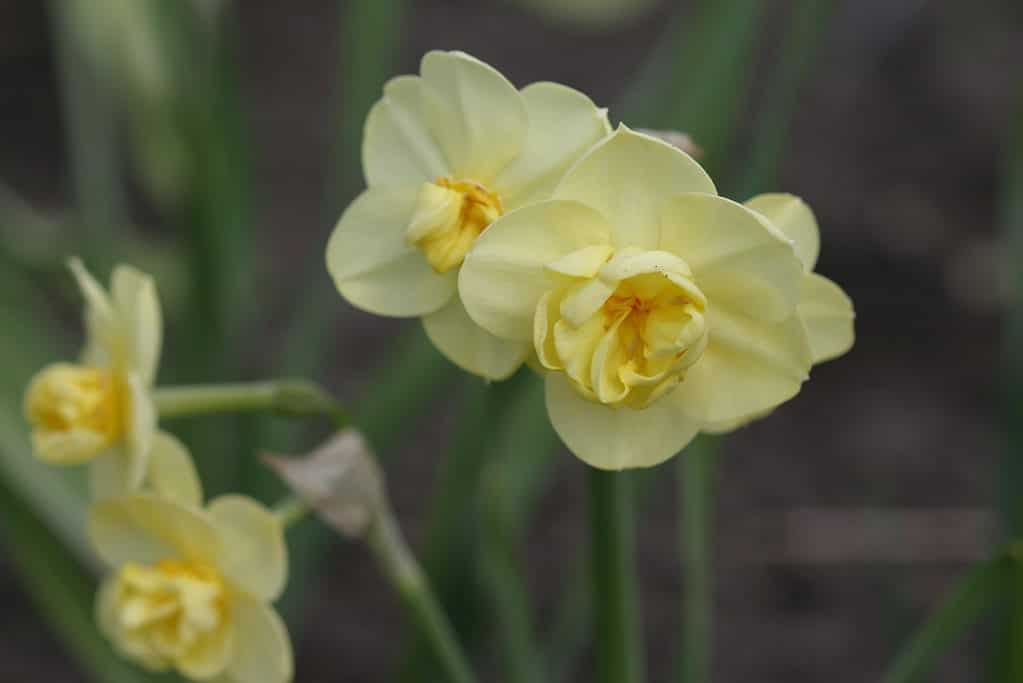
Fluffy ‘Cheerfulness’ is a white historic daffodil with yellow accents.
©Evgenia1969/Shutterstock.com
9. ‘Cheerfulness’ Daffodil
Plant Botanical Name: Narcissus ‘Cheerfulness’
Common Plant Names: ‘Cheerfulness’ daffodil, ‘Cheerfulness’ double daffodil
Plant Hardiness Zones: 4-8
Seasons in Bloom: Mid to Late Spring
Daffodil Division: Double (Division #4)
Flower Colors: White petals and white cups with yellow centers
Dating back to the early 1920s, ‘Cheerfulness’ is a white heirloom daffodil with white and yellow cups. This beautiful plant is also a double daffodil, which means it has double the petals and cup segments of most other varieties.
Award-winning and very fragrant ‘Cheerfulness’ daffodil grows up to 2 feet tall and produces 3-6 flowers per stem.

‘Golden Ducat’ double daffodils are heirloom varieties from the 1940s.
©Simon Groewe/Shutterstock.com
10. ‘Golden Ducat’ Daffodil
Plant Botanical Name: Narcissus’ Golden Ducat’
Common Plant Names: ‘Golden Ducat’ daffodil, ‘Golden Ducat’ double daffodil
Plant Hardiness Zones: 3-9
Seasons in Bloom: Mid-Spring
Daffodil Division: Double (Division #4)
Flower Colors: Yellow cups and petals
Like the ‘Cheerfulness’ cultivar, ‘Golden Ducat’ is also a vintage double daffodil. This sunny yellow heirloom plant produces 4-inch fluffy blooms on plants that mature at 1-2 feet tall.
In addition to its yellow garden glow, the ‘Golden Ducat’ historic daffodil has a very appealing citrus scent! Add that benefit to its showy golden flowers, and this heirloom introduced in 1946 is one to pass down to new generations of daffodil gardeners.

Some of the oldest heirloom daffodils are poeticus varieties.
©Rabbitti/Shutterstock.com
How old are the oldest heirloom daffodils?
According to PennState Extension, daffodils originated in Africa and Europe before the 1800s. However, during the 1800s is when growing and breeding daffodils became all the rage for home gardening. Then daffodils in the 1900s took the world by storm, and this is the century from which most of the daffodils on our list came.
Did you know that the New York Botanical Garden’s daffodil collection started with a plant donation in 1898? It’s true! In fact, the NYBC received 52 heirloom daffodils back then from Peter Barr, a British horticulturist known in his time as the Daffodil King.
Despite the great daffodil-growing boom of the 1800-1900s, the ‘Pheasant’s Eye’ daffodil might have them all beat. This historic daffodil comes from the early 1600s.
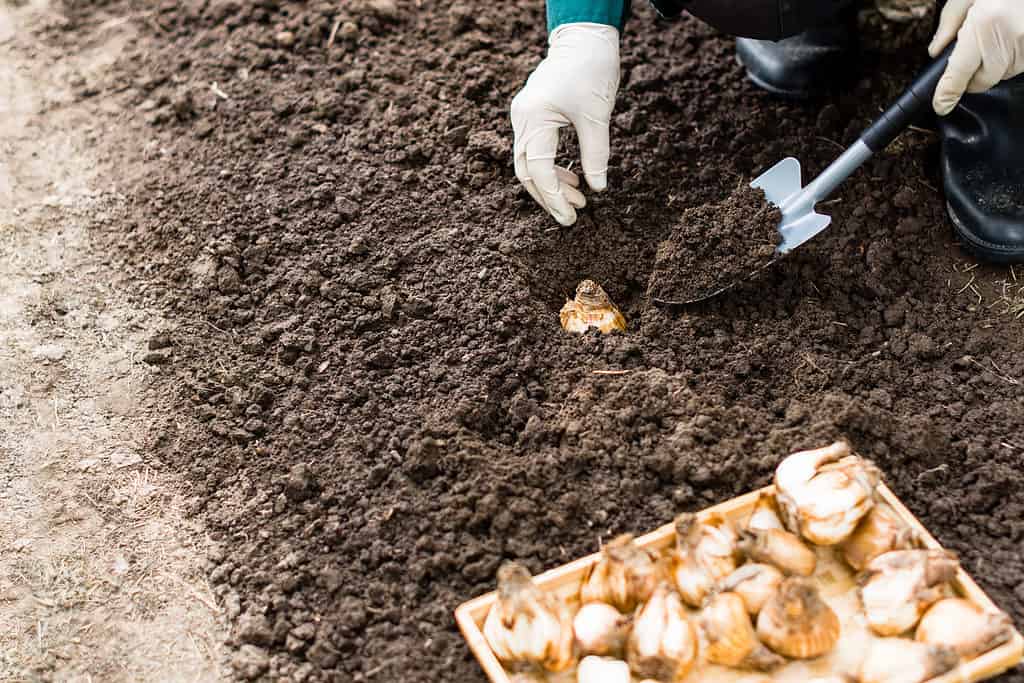
Always wear protective clothing when planting daffodil bulbs.
©Jurga Jot/Shutterstock.com
How to Plant Heirloom Daffodil Bulbs
Planting heirloom daffodil bulbs is a great way to add classic charm to your garden. It’s also just as easy to plant heirloom daffodils as it is to grow all the gorgeous modern hybrids. So heirloom daffodils are perfect flowering plants for beginner to experienced gardeners.
If you’re a daffodil newbie, here are a few quick tips for planting heirloom daffodils that come back every year:
- Wear protective gloves when handling daffodil bulbs and plants. Daffodils (especially their bulbs) contain a toxin called lycorine that can cause skin irritations. Because of the same toxin, don’t eat any part of the daffodil plant.
- Plant heirloom daffodil bulbs in autumn before the ground freezes. This timing allows the bulbs a necessary dormancy period in cold temps before the plants emerge from the ground in spring.
- Choose a sunny plot in your garden that gets 6-8 hours of sun per day.
- Dig a hole 2 inches deeper than the height of the bulb.
- Add a balanced fertilizer to the holes now, if you’re adding any at all.
- Place your bulbs in the soil with the pointed end facing up. Give the bulbs at least 6 inches of space between each one.
- Fill in the holes and give them a good dousing of water.
- Mulch over the planted bulbs to help protect them from freezing temperatures.
- Watch as your daffodil plants grow and bloom in spring!
Heirloom daffodils are a classic gift for modern gardeners.
Their charm, hardiness, and beauty make heirloom daffodils an excellent choice for any flower garden. In addition, their history gives these historic daffodils some trustworthy street cred in the world of sturdy bulb plants! They’re long-lasting, sweet-smelling, and a stunning sight to behold in the spring.
Plus, heirloom daffodils are easy to grow for newbie gardeners. How’s that for a great vintage gift to enjoy in modern times? Even better, heirloom daffodil bulbs make great gifts for all the present and future gardeners in your family.
The photo featured at the top of this post is © Mike Russell/Shutterstock.com
Thank you for reading! Have some feedback for us? Contact the AZ Animals editorial team.






